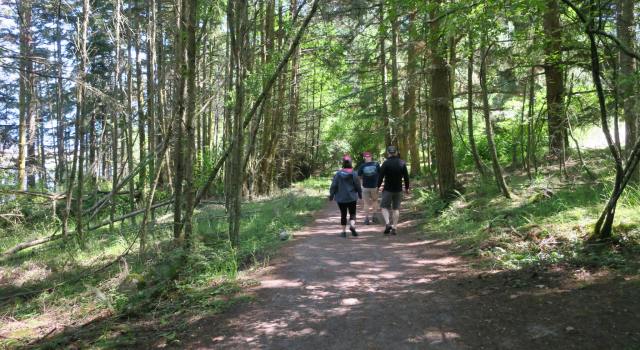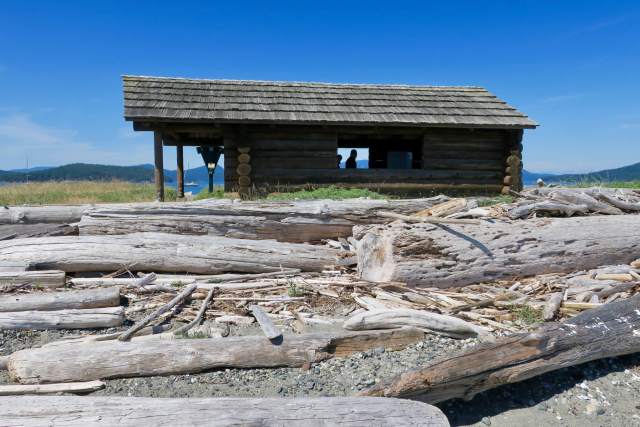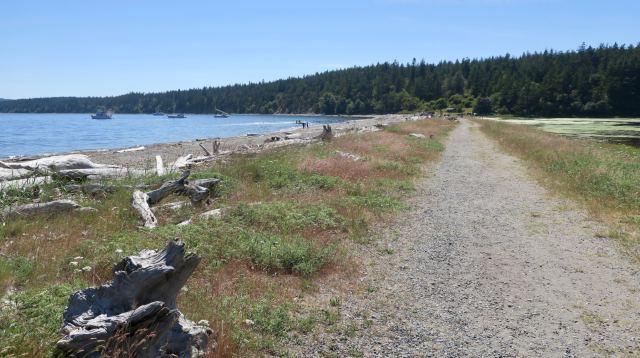Several dozen of Washington’s state parks are island-based marine parks, in many cases reachable only by water. A handful, fortunately, are accessible by road, including Spencer Spit State Park on Lopez Island. During a recent weekend visit with Mr. Adventure’s brother Adventure Bro and sister-in-law Adventure Sis, we hopped on our bikes and headed over to explore.
Saltchuck lagoon
The access road to Spencer Spit leads to the camping areas and some hiking trails, but we were interested in the shoreline, so we followed a short trail downhill to the namesake spit.

As its name suggests, Spencer Spit is just that: a long sandy spit jutting out into Lopez Sound. Unusually, the spit forms one side of a triangle surrounding a saltchuck lagoon. In Chinook Jargon, the trade pidgin that developed around Puget Sound and the Columbia River in the late 18th and early 19th centuries, “chuck” means water. Thus “saltchuck” means saltwater.


On Spencer Spit
Standing where the forest meets the shore, the spit stretches away into the distance, framed by Frost Island in the background. At some low tides, Spencer Spit connects to much-smaller Frost Island, with its scattering of private homes. We started walking out along a wide path. With blue skies above and blue water on either side, it was a perfect Northwest day.


A small log picnic shelter sits near the tip of the spit. This is the second replica of a guest cabin constructed by the Spencer family in the 1910s, who lived here and on nearby Blakely Island beginning in the 1880s. The Spencers were the third Euro-American owners of Spencer Spit. The spit is part of the traditional territory of the Samish peoples, a Coastal Salish indigenous linguistic and ethnic group. Interpretation inside the shelter explains the human and natural history of the spit.


The day was so clear, so fresh, so idyllically Pacific Northwest. I dragged my feet on the way back down the spit, inspecting interesting driftwood and gazing at boats on the cerulean water. I never want days like these to end.

Superhero Ranger!
But we had more park to see, so we headed toward an intriguing stone building near the base of the spit. Turns out this is a root cellar built by the Spencers and rehabilitated by Washington State Parks. As we looked inside, a ranger approached and asked if we had any questions.
Ranger Meghan Herold cheerfully explained about the park’s history and structures, and we got to talking about how the role of park rangers has changed over time. “We do everything,” she said. “Pick up trash, rake paths, register visitors, even clean bathrooms!” In fact, she added, Spencer Spit has some of the cleanest bathrooms of any state park, a fact the staff takes pride in. We promised to check them out.


Ranger Herold works about a nine-month season, with a few months off in midwinter. She’s been working at Spencer Spit for more than five years and loves interacting with visitors in this island landscape. Lopez Island’s nickname is Slo-pez, a nod to its laidback attitude. Park visitors quickly adapt to the slower pace, which might explain the torpor that overtook me as I lounged in the shade of the stone cellar, thinking about how lucky we are to have such dedicated, enthusiastic professionals in our woefully underfunded parks (more on that in a future post).


We were starting to think about lunch, so we headed back uphill through the forest to our bikes. After making the promised restroom stop — sparkling clean, as promised, and coolly retro, too — we saddled up and headed out. Passing the ranger station, Mr. Adventure spotted a Little Free Library box and stopped to peruse the offerings. It seemed like the perfect coda to our time at Spencer Spit.
Fast facts about Spencer Spit State Park
- 138-acre, year-round camping park
- $10 daily parking pass (buy the annual Discover Pass, a bargain at $30)
- campground with 37 standard sites, seven hiker/biker sites, three group camps, reservable during high season online or call 888-CAMPOUT
- several beach campsites available for those arriving via Cascadia Marine Trail
- picnic tables, picnic shelters, fire pit, nature center, playground, restrooms, kayak and bike rentals onsite
- hiking, biking, beach exploring, birdwatching, wildlife
- fishing, swimming, diving, clamming and crabbing (when permitted)
- 11 moorage buoys
- park map
- park brochure
